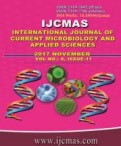


 National Academy of Agricultural Sciences (NAAS)
National Academy of Agricultural Sciences (NAAS)

|
PRINT ISSN : 2319-7692
Online ISSN : 2319-7706 Issues : 12 per year Publisher : Excellent Publishers Email : editorijcmas@gmail.com / submit@ijcmas.com Editor-in-chief: Dr.M.Prakash Index Copernicus ICV 2018: 95.39 NAAS RATING 2020: 5.38 |
Root rot disease of patchouli is caused by Fusarium solani (Mart.) Sacc. Eight isolates were collected from patchouli growing areas of Assam to study the cultural and morphological characteristics of F. solani. The colony diameter of eight isolates ranged from 81.55 mm to 90.00 mm at ten days after inoculation on PDA medium. The fastest radial growth (90.00 mm) was observed in isolates JFS1, JFS2 and NFS4 followed by isolates GFS8 (87.56 mm), BFS6 (87.46 mm), NFS3 (85.34 mm) and NFS5 (84.78 mm) whereas minimum radial growth was observed in isolate BFS7 (81.88 mm). All isolates produced micro, macro-conidia and chlamydospores. The size of macro conidia was ranged from 13-15 x 3-4 μm to 27-29 x 4-5 μm, size of micro conidia was ranged from 3-4 x 1-2 μm to 9- 10 x 1-3 μm, the number of septa in macro and micro conidia are 2-4 and 0-1 respectively and the colour is hyaline. All conidia were hyaline and macro conidia were sickle shaped with the blunt end, micro conidia was cylindrical and round to oval and chalamydospore were intercalary, terminal, globose to oval shaped in all the isolates. The septation of macro conidia is 2-4 and micro conidia were 0-1. Conidiophores were elongated and sparsely branched, each branch usually terminated with a spore bearing phialide. The most distinguished characters of long monophialidic conidiogenous cells were observed in all the isolates.
 |
 |
 |
 |
 |